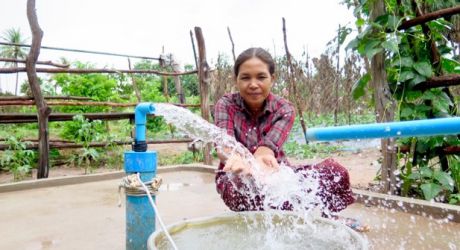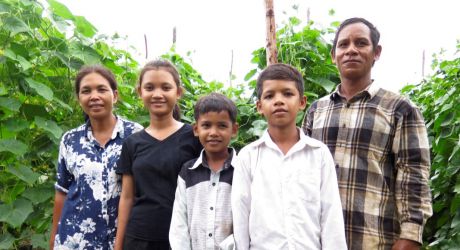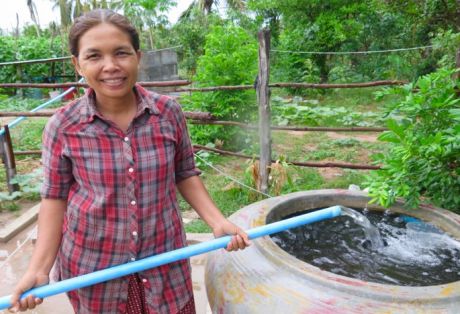Project Background
In Cambodia, people with disabilities are often among the poorest of the poor, are less likely to attend school and are more likely to depend on others for their livelihood. These factors, along with experiences of stigma and discrimination, act as barriers to being included in community water, sanitation and hygiene services. Women with disabilities in Cambodia may experience a ‘triple burden’ of discrimination based on being a woman living with a disability and being among the poorest in the community.
Accessing safe water and sanitation can be a greater challenge for people with disabilities as they may have difficulty getting to or using a water point or latrine. They may also be left out of community processes because they do not hear about the event or are unable to get to and from community meetings, or because the promotion methods are not appropriate for people with vision or hearing impairments.
Inclusive water, sanitation and hygiene occurs when the entire community, including people with a disability, the elderly, pregnant women, ethnic minorities and other marginalised groups benefit and participate equally from water, sanitation and hygiene programs, services and processes. Inclusive approaches to water, sanitation and hygiene encourage awareness of and participation by all marginalised groups.

Key Project Activities
- At commencement of the project, we held community engagement meetings to ensure the community were able to participate into the design and implementation the project. 271 families were represented. In these meetings, we identified the families who were most at need of a household disabled toilet and improved access to water.
- A barrier analysis session was held with 41 disabled persons. Speaking with these people enabled us to identify the barriers people with disabilities face when accessing water, sanitation and hygiene, such as, long distances to facilities, difficulties in walking to water supplies and toilets, uneven slippery paths, steep slopes, lack of information, stigma and traditional beliefs around disability.
- Barriers discovered amongst the community were used to inform project design and implementation.
- The community jointly decided on the most suitable location for their new water supply. We constructed a water-well closer to users with disabilities. The well was capped to prevent contamination and a hand-pump installed.
- We made paths to the water well smooth, non-slip and wide enough for wheelchair access.
- 98 of the most vulnerable households and those with elderly and disabled were given appropriate water collecting containers and ceramic water storage and filtering units to store water at home.
- Eight new disabled toilets were constructed in households with disabled family members.
- We established a community-disabled group. Members meet monthly to access counselling and referrals to health professionals with an understanding of disability. Members also come together to better understand their health and well-being and dis-cuss any challenges they may still be facing such as accessing water, and to find ways of overcoming these challenges.
- We held two public awareness-raising events on International day of the Disabled and Children’s Day. Disabled people were invited to join the events aimed at promoting inclusion and to begin the process of breaking down stigmas. We promoted these events through radio and posters around the community.
- We educated the community on low-cost solutions that families could use to make facilities at home more accessible for the disabled and elderly.
- We provided education to teachers, the school principal and Commune Council for Women and Children on inclusive education, child’s rights, disabled rights and identifying and accepting disability at school
- We held a disability and accessible water, sanitation and hygiene forum at the local and district council level. This forum has built the capacity of the Village Disabled People’s Committees by enabling them to plan, manage, implement, monitor and evaluate services for disabled people and the poorest families in the community.
Project Impact
- People with disabilities, their families and the community under-stand the importance of equitable access to safe, clean water and sanitation.
- Dignity has been restored to the disabled in the community, as they are better able to access community and household facilities.
- Stigma around disability in the community has decreased and will continue to decrease as the disabled become more involved and visible in the community, through simple things such as collecting their own water.
- Clean water has not only benefited the disabled, the entire community can share in safe, clean water. This has improved daily life as households not only have access to safe, clean water to drink; families now have water to produce vegetables and to raise their animals.
- The local school has committed to improving disabled infrastructure such as ramps, support bars, toilets and playgrounds. Parents of children with disabilities will be learn the importance of providing inclusive education and access to clean, safe water at school and home. Costs for these activities will generated by private donors.

Project Partners
As with all WaterAid projects, we work with a number of partners to en-sure we are able to successfully deliver our projects; including local, district and national government agencies; service providers; implementing partners, and of course the community itself. Starting with the Cambodian Government, we continue to work with them to raise their support and understanding of water, sanitation and hygiene particularly as it relates to equity and inclusion, and to ensure they include people with disabilities into their national action plans.
During this project, we engaged local NGO’s Disability Development Services Program (DDSP) and Clear Cambodia. Throughout the project, we met regularly with our partners to discuss better ways of working together and we sought and shared information such as improved access to health care and disabled toilet and water filter designs.

Case Study: Sovannary, Thkov village
Sovannary is 45 years old; she has three children and lives with her husband in Thkov village, Pursat province, Cambodia. Sovannary has been unable to walk properly since contracting a leg infection 30 years ago. In addition to her disability, Sovannary’s husband lacks secure employment. At best, the household monthly income is only AUD$50. This is not enough to send Sovannary’s youngest daughter to school and the family often goes without proper meals.
Sovannary told WaterAid that all her difficulties were so much harder to overcome by not having access to safe clean water and toilets. For example, having a disability meant she was unable to walk the long distances required to collect water. Without water, she was unable to care for her garden and grow enough fruit and vegetables to feed her family meaning her family often went without meals. The only water supply the family had access to was dirty and unsafe, and this meant members of Sovannary’s family often became sick. When her husband was sick, he was unable to work, and there was certainly no money to buy proper medicine.
Thanks to the disability inclusive water and sanitation project, WaterAid has built a water-well in Sovannary’s town. The well is located close to Sovanary’s home and the entire family is now able to access safe, clean water and toilets.
Sovannnary told us that having access to water has changed her life. Despite her disability, Sovannary is proud she is able to contribute to the wellbeing of her and family and community. Her family now earns up to $50 a day, a marked improvement from $50 a month. With a reliable and constant supply of water, Sovannary is able care for her garden like never before. Not only does she have enough food to feed her family, she is now selling surplus produce such as, cucumbers and snake beans to local markets. With a more reliable income, Sovannary is now able to pay the fees to send her youngest daughter to school.
Sovannary told WaterAid she dreams of sending all her three children to study at university in the hope that they will all secure good jobs and be able to provide for themselves well into future.
What's next?
Although the water component of this project is complete, WaterAid will facilitate monthly community group meetings and work with the community to ensure people with disabilities continue to access their new water supply, toilets and are included in daily community life. This includes, equipping the community with skills to maintain their water-well to ensure sustainability.
Can I visit this project?
Not at this time.
Project Overview
In Cambodia, people with disabilities are often among the poorest of the poor, are less likely to attend school and are more likely to depend on others for their livelihood. These factors, along with experiences of stigma and discrimination, act as barriers to being included in community water, sanitation and hygiene services. Women with disabilities in Cambodia may experience a ‘triple burden’ of discrimination based on being a woman living with a disability and being among the poorest in the community.
Accessing safe water and sanitation can be a greater challenge for people with disabilities as they may have difficulty getting to or using a water point or latrine. They may also be left out of community processes because they do not hear about the event or are unable to get to and from community meetings, or because the promotion methods are not appropriate for people with vision or hearing impairments.
Inclusive water, sanitation and hygiene occurs when the entire community, including people with a disability, the elderly, pregnant women, ethnic minorities and other marginalised groups benefit and participate equally from water, sanitation and hygiene programs, services and processes. Inclusive approaches to water, sanitation and hygiene encourage awareness of and participation by all marginalised groups.
The Footprints funding will contribute to improving inclusion of people with disabilities and the elderly in community life and the delivery of accessible safe water, sanitation and hygiene in one community in Pursat Province.

Project objectives and outcomes
Objective One:
People with disabilities gain access to safe water and sanitation
Outcomes:
- People with disabilities have access to a clean, sustainable water source.
- People with disabilities have access to and regularly use improved toilets rather than resorting to open defecation, resulting in a reduction of infected faecal material being present in the environment.
Objective Two:
Improve participation of people with disabilities in community life
Outcomes:
- People with disabilities actively participate in community decision making processes
- Communities recognise the rights of community members with disabilities
- Family members caring for people with disabilities are better supported
- Community members with disabilities form social support networks to have a stronger voice in the community and share and support each other
Objective Three:
Support inclusive hygiene education and services
Outcomes:
- People with disabilities and their families adopt improved hygiene practices and have access to materials to make hygiene practice accessible
- Local health and support services are connected and supporting with people with disabilities and their carers
Project partners and community involvement
WaterAid will work with implementing partners, people with disabilities, the community, service providers, and the local government to implement this project in line with four key principles:
1. Awareness of disability and its implications is the crucial first step in water, sanitation and hygiene programs becoming inclusive.
2. Participation of people with a disability is essential for meeting their needs and for genuine empowerment and community-led change.
3. Comprehensive accessibility ensures that physical, communication, policy and attitudinal barriers are all identified and addressed. This is more than physical access to infrastructure, but also to information and involving people with disabilities in community decision making.
4. Identify specific actions for people with a disability at the community level while establishing disability inclusion as common practice.
How this project fits into a larger strategy
The Cambodian government has committed to providing universal coverage of Water, Sanitation and Hygiene by 2025.
To help achieve this goal, WaterAid Cambodia is committed to improving the accessibility of safe water, sanitation and hygiene for all areas where people with disabilities, the elderly and pregnant women experience barriers to these essential services.
WaterAid is working at the national level to develop guidelines for accessible water, sanitation and hygiene services as well as at the local level to support communities, local government, and service providers to improve their practices to provide better outcomes for people with disabilities.